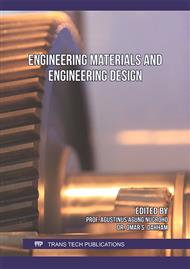[1]
J. M. Rosiak and F. Yoshii, "Hydrogels and their medical applications," Nucl. Instruments Methods Phys. Res. Sect. B Beam Interact. with Mater. Atoms, vol. 151, no. 1–4, p.56–64, 1999.
DOI: 10.1016/S0168-583X(99)00118-4
Google Scholar
[2]
J. Liu, L. Zhang, W. Hu, R. Tian, Y. Teng, and C. Wang, "Preparation of konjac glucomannan-based pulsatile capsule for colonic drug delivery system and its evaluation in vitro and in vivo," Carbohydr. Polym., vol. 87, no. 1, p.377–382, 2012.
DOI: 10.1016/j.carbpol.2011.07.062
Google Scholar
[3]
X. Luo, P. He, and X. Lin, "The mechanism of sodium hydroxide solution promoting the gelation of Konjac glucomannan (KGM)," Food Hydrocolloids, vol. 30, no. 1. p.92–99, 2013.
DOI: 10.1016/j.foodhyd.2012.05.012
Google Scholar
[4]
S. Vijayasekaran et al., "Poly(I-vinyl-2-pyrrolidinone) hydrogels as vitreous substitutes: Histopathological evaluation in the animal eye," J. Biomater. Sci. Polym. Ed., vol. 7, no. 8, p.685–696, 1996.
DOI: 10.1163/156856296X00453
Google Scholar
[5]
X. Wei et al., "Injectable hydrogel based on dodecyl-modified N-carboxyethyl chitosan/oxidized konjac glucomannan effectively prevents bleeding and postoperative adhesions after partial hepatectomy," Int. J. Biol. Macromol., vol. 199, no. January, p.401–412, 2022.
DOI: 10.1016/j.ijbiomac.2021.12.193
Google Scholar
[6]
S. A. Ghumman et al., "Synthesis of pH-Sensitive Cross-Linked Basil Seed Gum/Acrylic Acid Hydrogels by Free Radical Copolymerization Technique for Sustained Delivery of Captopril," Gels, vol. 8, no. 5, p.291, 2022.
DOI: 10.3390/gels8050291
Google Scholar
[7]
P. K. Veerasubramanian et al., "An investigation of konjac glucomannan-keratin hydrogel scaffold loaded with Avena sativa extracts for diabetic wound healing," Colloids Surfaces B Biointerfaces, vol. 165, p.92–102, 2018.
DOI: 10.1016/j.colsurfb.2018.02.022
Google Scholar
[8]
L. Zhou, T. Xu, J. Yan, X. Li, Y. Xie, and H. Chen, "Fabrication and characterization of matrine-loaded konjac glucomannan/fish gelatin composite hydrogel as antimicrobial wound dressing," Food Hydrocoll., vol. 104, no. September 2019, p.105702, 2020.
DOI: 10.1016/j.foodhyd.2020.105702
Google Scholar
[9]
H. Kanniyappan, P. Thangavel, S. Chakraborty, V. Arige, and V. Muthuvijayan, "Design and evaluation of Konjac glucomannan-based bioactive interpenetrating network (IPN) scaffolds for engineering vascularized bone tissues," Int. J. Biol. Macromol., vol. 143, p.30–40, 2020.
DOI: 10.1016/j.ijbiomac.2019.12.012
Google Scholar
[10]
M. Xiao et al., "Carboxymethyl modification of konjac glucomannan affects water binding properties," Carbohydr. Polym., vol. 130, p.1–8, 2015.
DOI: 10.1016/j.carbpol.2015.05.001
Google Scholar
[11]
S. S. Behera and R. C. Ray, "Konjac glucomannan, a promising polysaccharide of Amorphophallus konjac K. Koch in health care," Int. J. Biol. Macromol., vol. 92, p.942–956, 2016.
DOI: 10.1016/j.ijbiomac.2016.07.098
Google Scholar
[12]
L.X. Wang, L.X. Xiao, L.G. Cai, N. Yin, D.D. Kou, and J. Pang, "Influence of Konjac Glucomannan on the crystallization morphology and structure of calcium oxalate," Jiegou Huaxue, vol. 32, no. 6, p.831–838, 2013.
Google Scholar
[13]
W. D. Holloway, M. E. Argali, W. T. Jealous, J. A. Lee, and J. H. Bradbury, "Organic Acids and Calcium Oxalate in Tropical Root Crops," J. Agric. Food Chem., vol. 37, no. 2, p.337–341, 1989.
DOI: 10.1021/jf00086a014
Google Scholar
[14]
D. H. Wardhani, L. H. Rahayu, H. Cahyono, and H. L. Ulya, "Purification of Glucomannan of Porang (Amorphophallus oncophyllus) Flour using Combination of Isopropyl Alcohol and Ultrasound-Assisted Extraction," Reaktor, vol. 20, no. 4, p.203–209, 2020.
DOI: 10.14710/reaktor.20.4.203-209
Google Scholar
[15]
Rofi'ana, S. W. A. Suedy, and S. Parman, "Effect of Soaking of NaCl Solution on Reduction of Calcium Oxalate and Size of Amylum on Purple Yam ( Dioscorea alata L .)," NICHE J. Trapical Biol., vol. 1, no. February, p.1–6, 2018.
Google Scholar
[16]
A. Faridah, "Optimization of Multilevel Ethanol Leaching Process of Porang Flour (Amorphophallus muelleri) Using Response Surface Methodology".
DOI: 10.18517/ijaseit.3.2.309
Google Scholar
[17]
N. Nurlela, N. Ariesta, E. Santosa, and T. Muhandri, "Physicochemical properties of glucomannan isolated from fresh tubers of Amorphophallus muelleri Blume by a multilevel extraction method," Food Res., vol. 6, no. 4, p.345–353, 2022, doi: 10.26656/fr.2017.6 (4). 580.
DOI: 10.26656/fr.2017.6(4).580
Google Scholar
[18]
A. Manab, H. Purnomo, S. Bambang Widjanarko, and L. Eka Radiati, "Modification of Porang Flour by Acid and Thermal Process using Conventional Heating in Waterbath and Microwave Irradiation," Adv. J. Food Sci. Technol., vol. 12, no. 6, p.290–301, 2016.
DOI: 10.19026/ajfst.12.2963
Google Scholar
[19]
H. Yu, Y. Huang, H. Ying, and C. Xiao, "Preparation and characterization of a quaternary ammonium derivative of konjac glucomannan," Carbohydr. Polym., vol. 69, no. 1, p.29–40, 2007.
DOI: 10.1016/j.carbpol.2006.08.024
Google Scholar
[20]
J. Chen et al., "Multifunctional injectable hydrogels for three-in-one cancer therapy: Preoperative remission via mild photothermal-enhanced supramolecular chemotherapy and prevention of postoperative recurrence and adhesion," Chem. Eng. J., vol. 425, no. February, p.130377, 2021.
DOI: 10.1016/j.cej.2021.130377
Google Scholar
[21]
S. Wang et al., "A self-healing and injectable hydrogel based on water-soluble chitosan and hyaluronic acid for vitreous substitute," Carbohydr. Polym., vol. 256, no. December 2020, p.117519, 2021.
DOI: 10.1016/j.carbpol.2020.117519
Google Scholar



